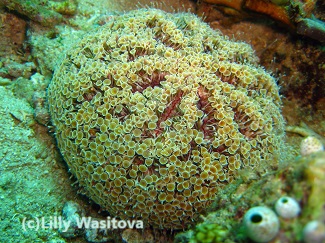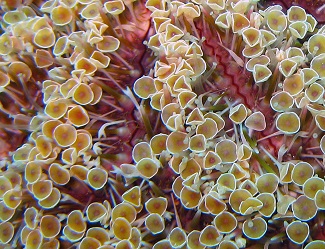Loading content - please wait...
Flower urchin trembles with danger
Flower urchin looks like a lovely ball of trembling flowers. However, those flowers contain highly toxic venom. This sea urchin’s maximum diameter is about 15 centimeters. It lives in areas of sand and rubble along coral reefs. It also inhabits areas of sea grass.
Beauty to Avoid
Although commonly known as the Flower urchin, the scientific name of this echinoderm is Toxopneustes pileolus. The genus name Toxopneustes means “poison breath.” And “skullcap” is the meaning of pileolus
, the species name. These names underscore the creature’s deadly possibilities.Its toxins can cause a number of symptoms. These include breathing problems, muscular paralysis, and numbness. Such effects can render the victim disoriented. The combination can result in accidental drowning. Initial contact gives the victim an extremely painful shock. Then numbness and spasms start to travel through the body from the point of contact. Happily, accidental contact with this sea urchin is extremely rare.
Deceptive Flowers
Various projections cover a Flower urchin’s exposed surface. The most noticeable are the flower-like pedicellariae. These colorful appendages are actually jaws. Each jaw has three prongs. Moreover, the flower-like jaws have sensors that detect contact or proximity movement to the sea urchin. Any touch will trigger the jaws to contract. Then the jaws inject venom. To make matters worse, once the jaws are triggered, they can easily break free from the sea urchin. That means they stay embedded and will continually inject venom for several hours.
The flowers of this sea urchin can appear a pinkish or yellowish white. There will be a single lavender dot in the middle. These false flowers typically cover the short spines of the urchin.
On the underside of the Flower urchin are double rows of tubular feet. These emerge along the ten segments of the urchin’s shell. In the center is the creature’s mouth, which contains five plates. These plates function as teeth that crunch food. Sea urchins forage along the bottom on algae, bryozoans and detritus. With the mouth facing the substrate, the anus faces the water column and any curious passing diver.
Flower Urchin Piled with Debris
To observe a Flower urchin, divers must keep a safe distance. Careful observation of the surface of this creature shows thin, translucent, and waving appendages that are longer that the trembling flowers of the urchin. These appendages are tubular feet that end in three claws. These are used to clear the urchin’s surface of debris.
However, the urchin also uses these tubular feet to move debris from the substrate onto its top and sides. Scientists call this covering or heaping behavior. The tubular feet keep debris in place. The function or purpose of this behavior remains a mystery. Because divers think that a small heap of debris is simply rubble, most flower urchins remain unnoticed.
In the rare instances when we see a Flower urchin, our dive masters will warn guests first and then carefully show the beautiful creature. Afterwards, the dive master will use his stick to move debris on top of the urchin. This helps the urchin but also prevents accidental contact by anyone else passing by.
To dive with such caring dive masters, please make your trip reservations directly with Miguel’s Diving.







